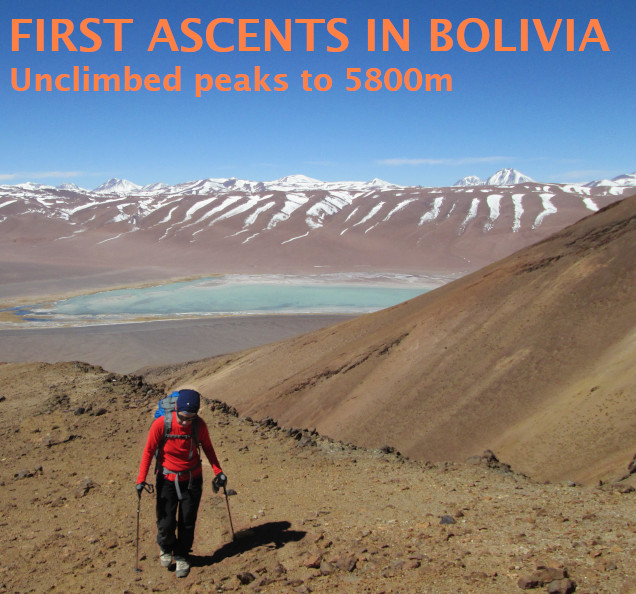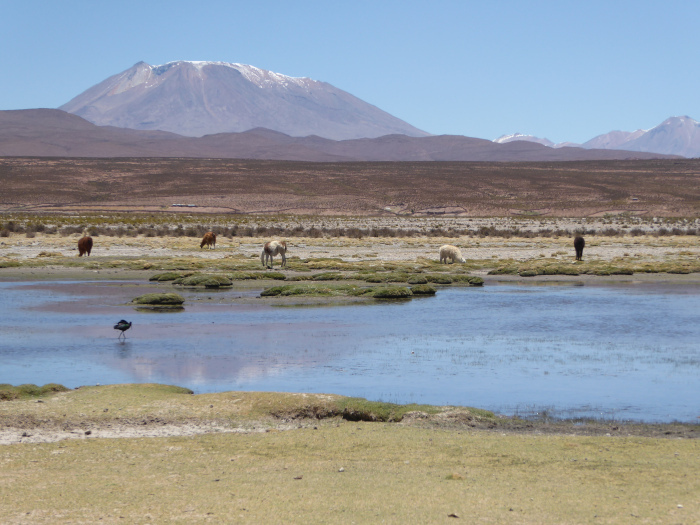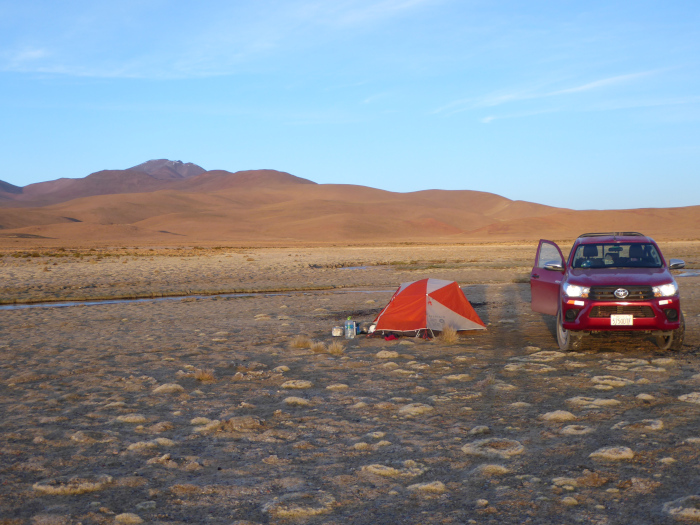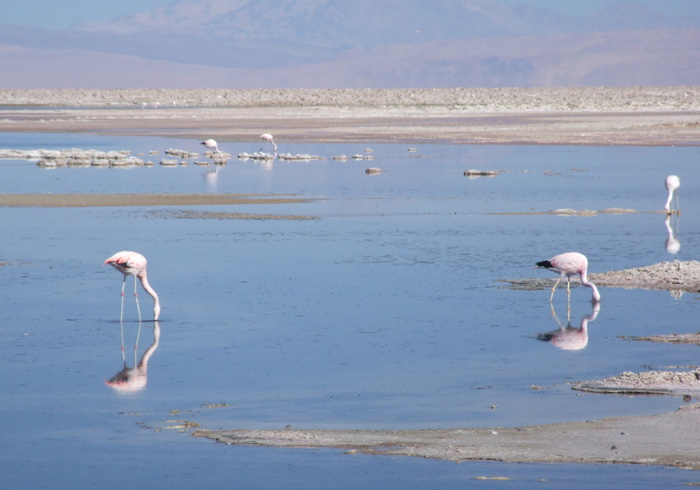 |
Dates |
1st - 16th November 2025 |
| Duration | 16 days | |
| Grade | 1B | |
|
"Andes" Leadership Fee
(includes leaders expenses) £2595 |
||
Easy High Altitude Ascents of unclimbed peaks in Bolivia.
Update 14-04-2025 - EXPEDITION FULLY BOOKED
PRICES & COSTS
All are per person.
"Andes" Leadership Fee (includes leaders expenses) -- £2595
Estimated Airfares from the UK -- £1500
Estimated Travel Costs in Bolivia -- £500
Estimated Accommodation & Meals -- £300
ESTIMATED TOTAL COST per person -- £4900
What's included in the price you pay ANDES and what's not.
INTRODUCTION
PLEASE NOTE :- All photos in this dossier are for illustrative purposes only and depict the general conditions we will encounter. They have been chosen to give a flavour of the expedition without giving away the peak names or identities to another expedition!!
Throughout the 2010's we made a number of first ascents of 6000m peaks in the high Andes of the Argentine Puna de Atacama and climbed new routes in remote Peruvian ranges (see our Firsts page for further details). These were very successful expeditions with many clients making many summits. We are heading back to the Andes in November 2025 for a similar trip, but this time to a remote corner of Bolivia. The peaks we will head to are in an area of the Andes we know well, having run several successful trips in the past few years.
We will fly out to La Paz at an altitude of 3700m, and then be based here for a few nights to begin acllimatising. The main part of the expedition is then a 10-day expedition into some remote parts of the Bolivian Altiplano. We'll use a mixture of camping and primitive rurral accommodation during this phase of the expedition. We plan to climb three peaks that are just under 6000m high, which we believe have never been climbed before. The ascents are all expected to be relatively straightforward; non-technical climbs over scree and boulders, and taking one to two days each. We'll have private transport in a 4x4 for getting between the mountain roadheads.
A FULL INFORMATION SHEET ON WHERE WE ARE PLANNING TO GO WILL BE AVAILABLE ONLY TO CLIENTS WHO HAVE PAID A DEPOSIT
Research on the internet and in all the regular mountaineering journals shows no indication that the main target peaks have been summitted previously, but we can't guarantee this. One potential problem is that some of these peaks were climbed for religious reasons at the time of the Incas, and indeed on a few expeditions in the past we have discovered unreported Inca ceremonial sites (e.g. on Alto Toroni in 2013). What we can say is that we have generally picked good target peaks for first ascents expeditions many times in the past.
Like most of the peaks in this part of the Andes the ascents on this expedition will not involve any technical climbing. They will be simple walks over rough ground and perhaps some boulders. The ascents are suitable for strong hillwalkers, ideally with expereicne of rough ground. Previous expedition experience is not essential but it is preferred due to the possibility of tough weather and camping conditions. There is a small chance we will have to use an ice-axe and crampons (but instruction can be given and previous experience of using these is not necessary).
NOTE ON THE ITINERARY
Please note that this itinerary is quite tight on aclimatisation time. we would recommend anyone who has any concerns about this to fly out to La Paz one or two days earlier. Please email or call to discuss details if necessary.

Llamas and Alpacas grazing on a bofedal - a typical Bolivian Altiplano scene.
General Information about our holidays
Please read our warning on altitude before booking this expedition to high altitudes.
Who runs 'Andes' and where we are based
General information about equipment, accommodation, flights, meals etc.
.
La Paz street carnival
LA PAZ
La Paz is the capital of Bolivia and the world's highest capital city. The nearby mountains provide some fresh air and the city has an agreeable climate. It gets warm in the sun during the day but, because of the altitude, quite cold every night. The main business district with its modern skyscrapers is set at about 3700m in the bottom of a canyon. The city stretches up and down the canyon from here; the rich live in the low-lying suburb of La Florida; the poorest people live on the steep sides of the canyon and in the district of El Alto. This is where the the international airport is, at over 4100m above sea level. We will have four nights in La Paz at the start of the expedition in order to begin our acclimatisation.
ACCLIMATISATION - LAGO TITICACA & CHACALTAYA
As part of our aclimatisation schedule we'll organise a full day tour to Lago Titicaca. Titicaca is famous as the world's highest navigable lake and it's certainly one of the most beautiful. The waters are clear and blue and there are fine views to the snow capped mountains of the northern peaks of the Cordillera Real. You can take a short boat cruise on the lake to see some of the fishing boats and islands and have trout for lunch (this is almost unavoidable when you go to Lago Titicaca). The cost of this tour is not included in our price.
The worlds highest ski 'resort' is an old rope tow and run-down cafe on the mountain called Chacaltaya just a few hours drive outside of La Paz. We'll organise a day trip to this mountain which will include taking in the short hike to the summit of Chacaltaya mountain, 5395m, for those feeling well enough acclimatised.
Approaching the summit of Chacaltaya, near La Paz. The peak in the background is 6094m high Huayna Potosi.
FITNESS & EXPERIENCE NEEDED
There is no difficult climbing involved in the ascents planned on this expedition. Snow and ice sections we encounter on this expedition should be straightforward. We may need to use an ice-axe and crampons for very short sections, but previous experience of winter walking is not essential. However clients should have good general high mountain or Alpine trekking experience, as you will be walking on rough ground and untracked terrain at heights well in excess of 5000m.
Climbing to such heights is always a serious matter because of the lack of oxygen at high altitude. For this expedition good mountain fitness and stamina are important, but for high altitude expeditions clients also need good cardiopulmonary (heart and lung) fitness. This can only be maintained, by a program of intensive exercise such as sprinting (not jogging), squash or sprint cycling. This should be done in small doses (e.g. an hour every other day) over a period of at least two months.
The trip is largely vehicle based. But on every main peak we will have quite a few nights camping at the "roadside", or up to half a days walk from the road. To get to these camps a rucksack of around 20kg may have to be carried for a few hours. Clients should be prepared for cold nights when camping and be prepared for windy and perhaps dusty weather at times out in the mountains. As we'll be a long drive from the nearest supermarket we will have to put up with some tinned and/or freeze-dried food in our meals during our time in the mountains. All clients are expected to help a little with the routine work of this type of expedition; pitching tents, cooking and washing up

Roadside camping on the Bolivian Altiplano.
CLIMATE
The climate at altitude in the Bolivian Andes is very cold and extremely dry. In the mountains temperatures can fall to -10ºC at night. During the day in the mountains it often feels very warm in the strong sun, but it can also be bitterly cold and windy. It will probably be dry all the time we are in South America, but there is a chance of a snow flurry, or occasional afternoon thunderstorm, in the mountains. As we are near the tropics come prepared for about 10-11 hours of darkness every night.
ORGANISATION & LEADERSHIP
Our expeditions are designed to be small and flexible. The expedition will be co-ordinated, organised and lead by us, but we will consult and involve the expedition members when planning the day-to-day details of the trip. Please note however that the leaders decision is final where the safety of the group or any member is in jeopardy; for example where retreat or diversion is necessary due to altitude illness or bad weather. The minimum group size we need to run this expedition is three clients. The maximum size of this expedition will be four clients plus leader.

Flamingoes on the Bolivian altiplano
INSURANCE, HEALTH & SECURITY
All clients must be insured for medical costs and repatriation in an emergency. We recommend having insurance for baggage, personal liability and cancellation as well. If you would like further advice please ask. Vaccinations for tetanus, typhoid and polio are recommended.
SAFETY AND RISK
This is an adventure holiday and all
clients will be exposed to hazards not found in
everyday life by taking part in this itinerary. While we take all
reasonable precautions to reduce risk it is neither possible nor desirable
to completely eliminate these hazards. It is important that you understand
the hazards you may be exposed to before
signing our booking form. We have identified the following areas as the
principal additional risks of this itinerary. (Some of
these could potentially result in serious injury or death). This is
not a fully inclusive list - a more detailed risk assessment of this itinerary
is available on our
Risk Assessments page, or phone/e-mail us
and ask some questions!
Driving, hotels and general
safety : In Bolivia the driving, fire standards and general safety standards are
not as high as in Europe, although they are good
Extreme remoteness : You will be
camping and travelling in remote areas for several nights and therefore obtaining
medical assistance for any problem will be a slow process, taking many hours.
There is no chance of a helicopter rescue.
Minor slips and falls : due to
steep, uneven and unstable ground.
Weather : This area is
occasionally affected by severe and sometimes dangerous storms, including
thunderstorms. There are sometimes high
winds. Forecasts are
not so reliable.
Altitude : At high altitudes there is an increased risk of
medical problems, most obviously altitude illness.
Mountain Hazards : In certain places you may be subjected to a slight risk
of rock fall, or slip on icy terrain or steep snow.

Typical view from a high summit on the Bolivian Altiplano.

